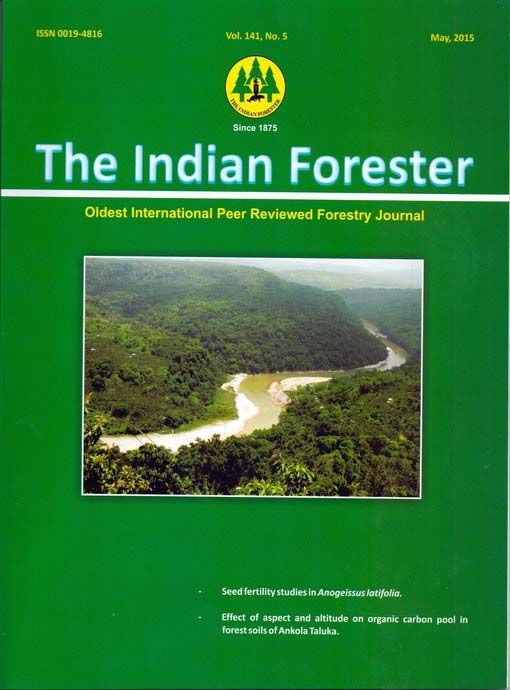In Vitro Growth Enhancement of Ectomycorrhizal Fungus Scleroderma Bovista by Two Mycorrhizosphere Bacteria
DOI:
https://doi.org/10.36808/if/2015/v141i5/70259Keywords:
ECM Growth Enhancement, Scleroderma Bovista, Mycorrhiza Helper Bacteria, Ectomycorrhizal.Abstract
Five bacterial strains namely, Bacillus subtilis MB14, Bacillus sp. MB10, Pseudomonas elongata MB11, P. fluorescens MB9 and Pseudomonas sp. MB1, isolated from banj oak (Quercus leucotrichophora A. Camus) mycorrhizosphere were tested for their effect on growth of ectomycorrhizal (ECM) fungus Scleroderma bovista in plate and flask experiment. Treatment of P. fluorescens MB9 culture filtrate on S. bovista yielded highest biomass (158.4 mg), as compared to control (94.0 mg). Moderate growth enhancement of ECM fungus was observed by B. subtilis MB14 treatment, while other three isolates moderately decreased S. bovista growth. Reduction in pH of growth medium was also observed. A strong linear regression (R2 = 0.925) between ECM fungal biomass and final pH of growth medium was observed.References
Anderson A.J. (1988). Mycorrhizae-host specificity and recognition, Bulletin of American Phytopathological Society, 78(3): 375-378.
Bergey D.H. and Holt J. (2000). Bergey's manual of determinative bacteriology, 9 ed. Williams & Wilkins, Philadelphia.
Bonfante P. and Anca I.-A. (2009). Plants, mycorrhizal fungi, and bacteria: a network of interactions, Annual Review of Microbiology, 63: 363-383.
Bowen G.D. and Theodorou C. (1979). Interactions between bacteria and ectomycorrhizal fungi, Soil Boilogy and Biochemistry, 11: 119-126.
Dahm H., Ró¿ycki H., Strzelczyk E. and Li C.Y. (1993). Production of B-group vitamins by Azosprillum spp. in media of different pH at different temperatures, Zentralblatt Fuer Mikrobiologie, 48(3): 195-203.
Dahm H., Strzelczyk E., Ciesielska A. and Redlak K. (1998). The effect of ectomycorrhizal fungi and bacteria on pine seedlings, Acta Mycologica, 33(1): 25-36.
Davey C.B. (1971). Non pathogenic organisms associated with mycorrhizae, Hacskaylo, E. (Ed.), Mycorrhizae. USDA Misc. Publication, pp. 114-121.
Duponnois R. and Garbaye J. (1990). Some mechanisms involved in growth stimulation of ectomycorrhizal fungi by bacteria, Canadian Journal of Botany, 68: 2148-2152.
Duponnois R. and Garbaye J. (1991). Mycorrhization helper bacteria associated with the Douglas fir- Laccaria laccata symbiosis: Effects in aseptic and in glasshouse conditions, Annales des Sciences Forestieres, 48(3): 239-251.
Garbaye J. (1994). Transley Review No. 76: Helper bacteria: a new dimension to the mycorrhizal symbiosis, New Phytology, 128: 197-210.
Garbaye J. and Bowen G.D. (1987). Effect of different microflora on the success of ectomycorrhizal inoculation of Pinus radiata, Canadian Journal of Forest Research, 17: 941-943.
Garbaye J. and Bowen G.D. (1989). Ectomycorrhizal infection of Pinus radiata by some microorganisms associates with the mantle of ectomycorrhizas, New Phytology, 112: 383-388.
Garbaye J., Churin J.L. and Duponnois R. (1992). Effects of substrate sterilization, fungicide treatment and mycorrhization helper bacteria on ectomycorrhizal formation of pedunculate oak (Quercus robur) inoculated with Laccaria laccata in two peat bare root nurseries, Biology and Fertility of Soils, 13(1): 55-57.
Garbaye J. and Duponnois R. (1992). Specificity and function of mycorrhization helper bacteria (MHB) associated with Pseudosuga menziesii-Laccaria laccata symbiosis, Symbiosis, 14: 335-344.
Garbaye J., Duponnois R. and Wahl J.L. (1990). The bacteria associated with Laccaria laccata ectomycorrhizas or sporocaps: Effects on symbiosis establishment on Douglas fir, Symbiosis, 9: 267-273.
Imolehin E.D. and Grogan R.G. (1980). Effect of oxygen, carbon dioxide and ethylene on growth, sclerotial production, germination and infection by Sclerotina minor, Phytopathology, 70: 1158-1161.
Kuek C. (1996). Shake flask culture of Laccaria laccata, an ectomycorrhizal basidiomycete, Applied Microbiology and Biotechnology, 45: 319-326.
Landeweert R., Hoffland E., Finlay R.D., Kuyper T.W. and van Breemen N. (2001). Linking plants to rocks: ectomycorrhizal fungi mobilize nutrients from minerals, Trends in Ecology & Evolution, 16(5): 248-254.
Leyval C. and Reid C.P.P. (1991). Utilization of microbial siderophores by mycorrhizal and non-mycorrhizal pine roots, New Phytologist, 119(1): 93-98.
Linderman R.G. (1988). Mycorrhizal interactions with the rhizosphere microflora: The mycorrhizosphere effect, Phytopathology, 78: 366-371.
Marx D. (1970). The influence of ectotrophic mycorrhizal fungi on the resistance of Pine roots to pathogenic infections. V. Resistance of mycorrhizae to infection by vegetative mycelium of Phytophthora cinnamomi, Phytopathology, 60(10): 1472-1473.
Rambelli A. (1973). The rhizosphere of mycorrhizae, Ectomycorrhizae, their Ecology and Physiology. Academic Press, New York, pp. 299-349.
Staatsma G., Van Griensven L.J.L.D. and Bruinsma J. (1986). Root influence on in vitro growth of hyphae of the mycorrhizal mushroom Cantharellus cibarius replaced by carbon dioxide, Physiologia Plantarum, 67: 521-528.
Szaniszlo P.J., Powell P.E., Reid C.P.P. and Cline G.R. (1981). Production of hydroxamate siderophore iron chelators by ectomycorrhizal fungi, Mycologia, 73: 1158-1174.
Trappe J.M. (1977). Selection of fungi for ectomycorrhizal inoculation in nurseries, Annual Review of Phytopathology, 15: 203-222.
Yadav A. and Yadav K. (2012). Physiological study of two ectomycorrhizal fungi isolated from Kumaun Himalaya, Indian Forester, 138(1): 17-21.
Downloads
Downloads
Published
How to Cite
Issue
Section
License
Unless otherwise stated, copyright or similar rights in all materials presented on the site, including graphical images, are owned by Indian Forester.





